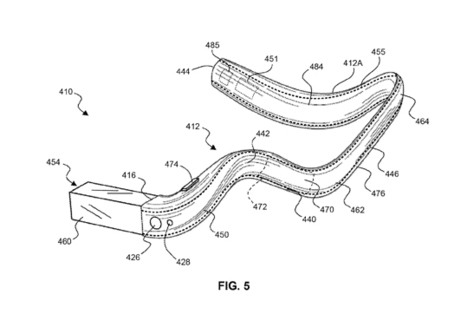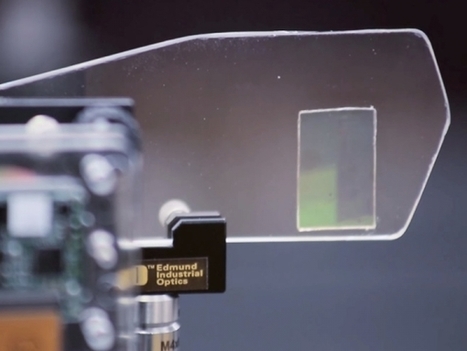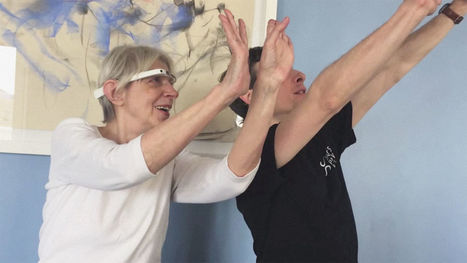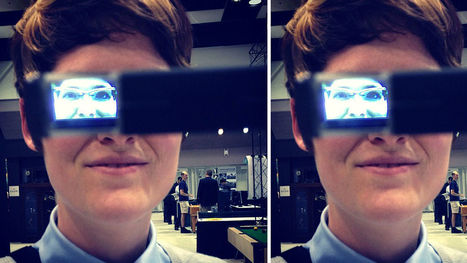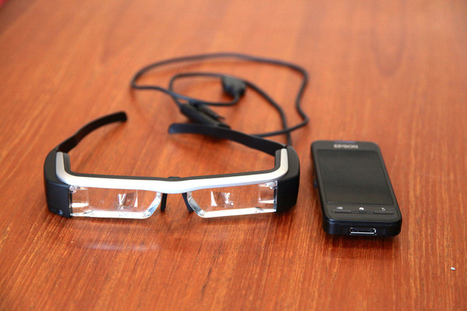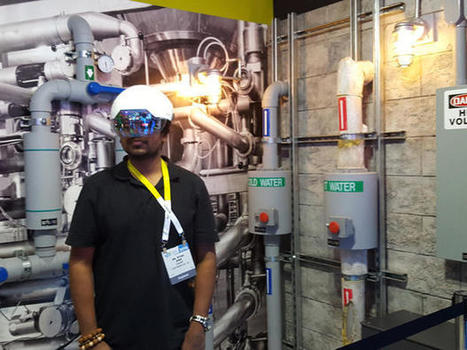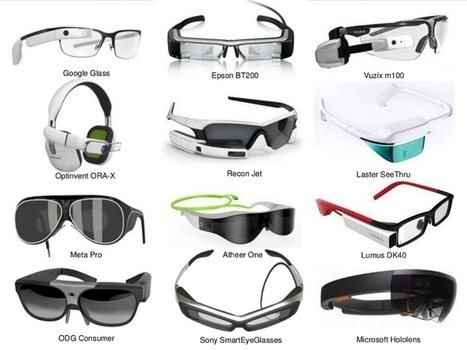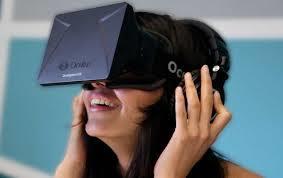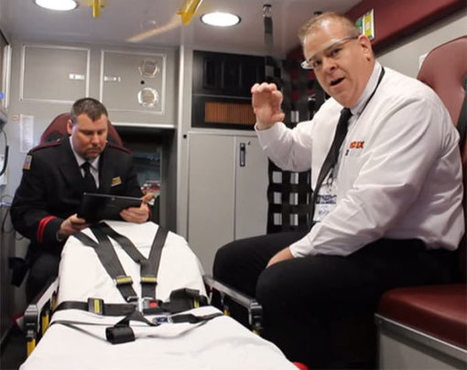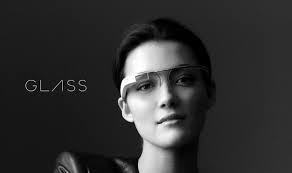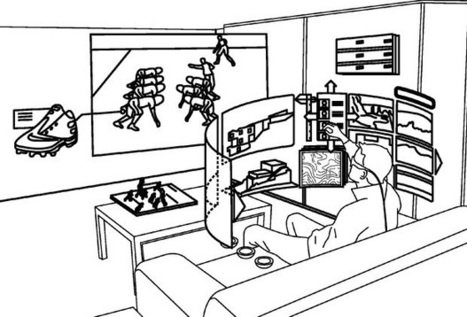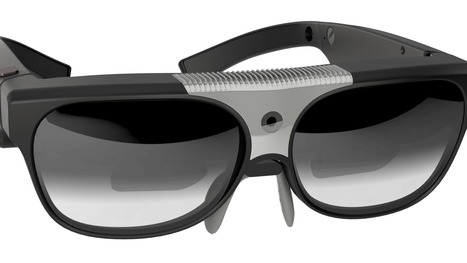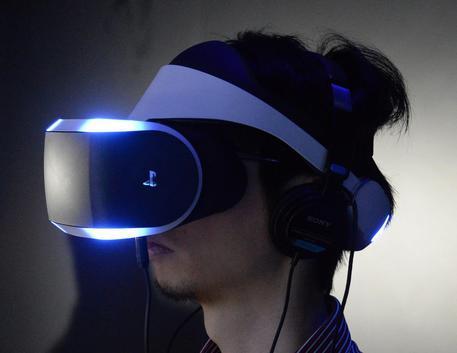 Your new post is loading...
 Your new post is loading...
"Smart" eyewear -- that can integrate augmented reality with your own, feed you live information about your surroundings and even be used in the operating room -- is no longer the stuff of science fiction.
Wearable displays also have the potential to enhance cognitive ergonomics, or more simply, make it less mentally taxing to complete certain tasks. But before technologies like Google Glass become a part of daily life, engineers need a way to monitor exactly how they affect the brain in everyday situations.
At Drexel University, researchers have developed a portable system that can do just that. The system uses functional near-infrared spectroscopy, or fNIRS, to measure a person's brain activity.
The applications for fNIRS are seemingly endless -- from training air traffic controllers and drone operators, to studying how students with disabilities learn best, or why different people are more receptive to certain Super Bowl commercials.
"This is a new trend called neuroergonomics. It's the study of the brain at work -- cognitive neuroscience plus human factors," said Hasan Ayaz, PhD, associate research professor in the School of Biomedical Engineering, Science and Health Systems and a member of Drexel's CONQUER Collaborative. The phrase was coined by the late Raja Parasuraman, a former professor at George Mason University and study co-author.
Until now, most studies involving fNIRS took place indoors. Though participants wearing the system could move around freely while being monitored, they were still observed within laboratory confines.
A group of Drexel biomedical engineers, in collaboration with researchers at George Mason University, have now brought their portable fNIRS system "into the wild." In their study, published this summer in Frontiers in Human Neuroscience, the researchers successfully measured the brain activity of participants navigating a college campus outdoors.
The researchers wanted to compare one group of participants navigating campus with Google Glass to another group using Google Maps on an iPhone. Their goal was to measure mental workload (how hard the brain is working) and situation awareness (the perception of environmental elements), in order to see which device was less mentally taxing.
They found that overall, users using Google Glass had a higher situation awareness and lower mental workload than their peers navigating with an iPhone.
However, the researchers also found that users wearing Google Glass fell victim to "cognitive tunneling," meaning they focused so much more of their attention to the display itself, that they easily ignored other aspects of their surroundings.
"What we were able to see were the strengths and weaknesses of both. Now that we know we are able to capture that, we can now improve their design," said Ayaz, the study's principal investigator. "This opens up all new areas of applications. We will be able to analyze how the brain is functioning during all of these natural activities that you cannot replicate in artificial lab settings."
fNIRS is a way to measure oxygenation levels in the prefrontal cortex -- the part of the brain responsible for complex behaviors like decision making, cognitive expression and personality development. Greater activity in this area of the brain signals that a person is a novice, and therefore must work harder, at an activity. When someone masters a skill, the processing of information moves toward the back regions of the brain.
In the past, researchers had to use secondary tasks to measure the "user-friendliness" of an augmented reality product, like Google Glass. For instance, while a person was navigating with a maps application, they would be asked to recall a series of sounds played to them through headphones. If their responses were inaccurate, this implied that their brain had to work harder to pay attention to the primary task at hand.
For comparison, the Drexel researchers also used secondary tasks to measure mental workload and situation awareness. However, they found that these tasks were intrusive and ultimately unnecessary. The fNIRS system was able to accurately assess brain activity during the task and examine differences between a hand-held display and wearable display.
"We observed greater mental capacity reserves for head-mounted display users during ambulatory navigation based on behavioral and neuro-metabolic evidence. However, we also observed evidence that some of the advantages of head-mounted displays are overshadowed by their suboptimal display symbology, which can be overly attention grabbing," said Ryan McKendrick, PhD, the study's lead author and now a cognitive scientist at Northrop Grumman Corporation.
Since the research team found that Google Glass users experienced some cognitive tunneling while navigating, they suggest that future studies identify other brain biomarkers induced by this "blindness" to the outside world. By identifying cognitive tunneling biomarkers, engineers could "greatly advance display design for navigation, training and other tasks" that wearable displays are expected to enhance.
Dopo la bufera per il prezzo di lancio di Oculus Rift, qualche considerazione a freddo sulle esperienze virtuali disponibili oggi. E su quelle che ci aspettano Tanto tuonò che piovve. Virtualmente, sia chiaro. Mentre rimane difficile sapere se sarà Oculus Rift a traghettarci in massa verso lidi immersivi a 360 gradi, è il prezzo dell’headset virtuale di Facebook – 599 dollari per gli States, 742 euro tasse e spedizione incluse dalle nostre parti – a produrre la prima rivoluzione fra il pubblico, in subbuglio dopo l’annuncio: un costo non alla portata di ogni tasca, cui va sommato quello di un computer dai requisiti minimi non proprio minimali, quantificabili fra i 1000 e i 1500 euro aggiuntivi. Per farla breve, oggi il biglietto per immergersi nel futuro sintetico costa quasi 2mila euro. Confort di alta gamma non compresi nel prezzo. Eppure, nonostante anche le impressioni di Wired non siano univoche – si passa dall’ottimismo dell’edizione americana ai nostri toni più prudenti – pare che tutti concordino sul fatto che liquidare il Rift spacciandolo per l’ennesima chimera del virtuale sia una bocciatura quantomeno frettolosa. E non tanto perché sulle superbe potenzialità economiche dell’infante, analisti e attori in gioco convengano (Cta e Gfk prevedono che, nel solo 2016, il fatturato globale della VR toccherà i 540 milioni di euro, una crescita del 440% anno su anno); piuttosto perché a prescindere dal Rift, dal Vive Pre (in uscita ad aprile e con un prezzo che le ipotesi vorrebbero sui 1500 euro), da PlayStation VR (800 euro secondo un leak di Amazon Canada, smentito da Sony), ebbene a prescindere da qualsiasi visore magari ancora da progettare, una e una sola cosa è certa: il nostro domani sarà virtuale. E almeno aumentato.
Mobile technology a hot topic, while big data and security take a back seat. The customer continues to be the brightest star in retail, according to presenters and exhibitors at the National Retail Federation’s Big Show in New York this week.
Apple's latest hire hints that it's exploring VR technology. Apple has added another notable name in the virtual reality industry to its team.
Augmented-reality devices are developing faster and more intelligently than ever, with big brands and start-ups keen to get involved Imagine having a volume button for the world – a selective one, built to “turn down” life’s annoyances – howling babies silenced with a button press; the rumble of traffic reduced to a distant hum. It is all done via a pair of hi-tech earbuds controlled by a smartphone app that “edits out” unwanted sounds, without leaving people deaf to things that they DO need to hear, such as a blaring horn of a car bearing down on them, or a friend talking nearby.
La societa di Mountain View è sempre alla ricerca di nuove soluzioni per rendere più facile la nostra vita. Un nuovo brevetto è stato depositato da Google, si tratta di un dispositivo “indossabile” stile Google Glass di cui circolavano da tempo voci di una nuova versione, ma con un disegno diverso dai precedenti occhiali destinato a coprire un solo occhio e orecchio.
Imagine that you are the Chief Security Officer for a large enterprise organisation and you suddenly find a small TV crew working its way through your offices, panning a video camera back and forth, recording who knows what: product schedules on white boards, financial reports lying about on desks, an org chart pinned to a wall, customer data displayed on screens - all sorts of confidential information. There would be an audio track, as well, recording hallway conversations about customers, product problems, release schedules, sales probabilities - the possibilities are endless. As CSO, you would probably scramble to grab any uniformed guards in the building and stop the TV crew in its tracks. You might, if possible, confiscate their recording. After all, if the recorded information were leaked, it could trigger all sorts of regulatory fines.
To date, Augmented Reality (AR) has been referred to as “the biggest technological advancement of our lifetime” by some, a mere “gimmick” by others or, worst yet, the next iteration of the QR code. The divisive term was introduced more than 25 years ago (although elements of AR technology have been used in science labs around the world since the mid-20th century), but if there’s one thing AR proponents and its naysayers can agree on, it’s the simple fact that AR, as we know it today, has an image problem.
While Google Glass is on a temporary hiatus, researchers in the U.K. have developed a new augmented reality headset that just could be the headset that everyone wanted from Google Glass. The device basically clips to the side of the wearer's glasses, and while it is still a prototype, the developers behind it want it to be used by everyone from surgeons to firefighters.
According to the National Parkinson Foundation, Parkinson’s disease is the second most common neurodegenerative disease after Alzheimer’s, affecting about 1 million Americans and an estimated 4 million people around the world.
Intel is joining the hordes of tech companies hopping on the augmented reality bandwagon by snapping up a 30% stake in the smart-glasses manufacturer Vuzix.
A small robot floated in my vision and asked a simple question: Where would I like to go? His name was Sparky, and he was developed especially for the Epson Moverio BT-200 augmented reality glasses I was wearing by a team of students at Carnegie Mellon’s Entertainment Technology Center. He quickly provided me details about a coffee shop down the block. If I’d stood up, he could have led me all the way there with turn-by-turn directions.
More BMW workers may begin wearing glasses at the vehicle manufacturing facility in Greer – even employees with perfect vision. These glasses deliver images otherwise not seen, along with features normally associated with a smartphone.
|
"Virtual reality will grow, just as the telegraph grew to the telephone—as the radio to the TV—it will be everywhere."
While the above quote may sound like it was pulled from a recent analyst report on the emergence of augmented reality (AR) and virtual reality (VR), it's from the 1992 film The Lawnmower Man, a reminder of the last flurry of interest and activity in the VR space that fizzled out nearly as quickly as it captured public attention. Recently, interest has been rekindled in AR and VR, and you could be forgiven for feeling that we've all seen these prognostications before and can safely ignore this technology once again.
What are augmented and virtual reality? Like most emerging technologies, there is some confusion and overlap to the terms augmented reality and virtual reality. At a basic level, AR entails the presentation of digital information as an overlay on your visual reality. Consider a car that projects maps and directions onto the windshield, augmenting your view of the road with information about traffic and the next turn.
A more sophisticated AR could also display objects with which you can manipulate and interact. For example, a consumer might use AR glasses to display a new couch in his living room, and then use his hand to move the virtual couch around the room, change its color, or swipe between different styles of furniture. VR suggests a more immersive experience, where one or more of your senses are provided with a computer-generated or cinematic reality.
A great and low-cost VR experience that uses your existing smartphone can be had with Mattel's new VR View-Master. Load the app, place your phone in the plastic View-Master, and you can be transported to space, Roman ruins, or an African savannah, with graphics that far exceed what we experienced in the 1990s, all for around 30 dollars.
The View-Master can also be used like a Google Cardboard device, so it's compatible with most Cardboard apps you might find in the Google Play store or the App Store. It's easy to see the applications in industry for these technologies. AR could allow a remote technician to phone a friend who can provide expert diagnostic assistance from across the world, or allow an assembly line inspector to view checklists and inspection manuals while looking at a part.
Designers and engineers could view and manipulate virtual 3D prototypes right from their desk, while an executive could have a live financial dashboard projected on her glasses as she reviews company performance. VR might seem like the more science fiction technology, yet there are also compelling applications. An engineer might virtually inhabit a robotic drone operating in a hazardous area, while a surgeon could practice a complex operation at the kitchen table.
Why now? While these applications are exciting and interesting, in many cases they are similar to the applications of AR and VR being touted in the 1990s. It's easy to point to cheaper and better technology as the key difference, but we've been living with Moore's Law for decades, and it did nothing to stir VR from its dormancy until now. One contributing factor that's changed, however, is that most humans have now experienced a limited version of AR and VR in the guise of the smartphone. It may offend purists to suggest that the early BlackBerries were AR devices, but they essentially augmented our physical reality with digital information.
During the first predicted VR revolution, the idea of getting a phone call, let alone a picture or digital message from anyone at any time, was far-fetched, yet now it's routine to see whole families staring at screens while sitting at the dinner table. Without so much as an Oculus Rift or HoloLens, we've essentially been augmenting our reality for years. Moving the digital content we've been consuming from a smartphone to a wearable device is more like changing the channel than first experiencing television.
Despite some early failures like the consumer adoption of Google Glass, as these devices become lighter and less conspicuous, interacting with our digital world that's presented in our field of vision will ultimately replace the comparatively clunky smartphone.
What does this mean for IT leaders? Despite the hoopla, the AR and VR revolutions are still in their infancy, except for some key functional roles, primarily in design, engineering, manufacturing, and field support. Rather than buying a dozen VR headsets, consider how your IT infrastructure will adapt and evolve to a state where IT is more about capturing, analyzing, and presenting data than building monolithic applications.
If you've been actively participating in the transition toward mobile devices, you're likely already thinking along these lines. The true asset of IT will be in the conclusions it can draw from massive amounts of data, and the presentation layer will ultimately become a personal decision of the data consumer. Start planning for this migration today, and you'll be prepared for whatever mobile, augmented, or virtual reality heads our way.
Other options superior for quality control, hazardous environments A report from independent research and advisory firm Lux Research Inc. has identified Google Glass coming up short in many usage cases, with smart glasses like Sony’s SmartEyeglass and Osterhout Design Group’s R-7 better suited for the needs of industrial workers, customer service reps and quality control agents. The report categorized more than 70 enterprise deployments of smart glasses, focusing on three aspects of core criteria – access to information, real-time communication, and documentation.
The technical challenges in streaming a 360 video is huge. Facebook is preparing for a world in which video is no longer flat. The social network’s push into virtual reality with its Oculus Rift along with similar initiatives by Microsoft and Google is expected to create a flood of video for the devices. Meanwhile, companies like GoPro FB 4.01% are developing cameras that people can use to film themselves in 360 degrees while skydiving and snowboarding.
Apple has hired one of the top US researchers in virtual reality, as it looks to catch up to Facebook, Alphabet, Microsoft and Samsung in what many see as the next big shift in computing platforms.
Doug Bowman recently joined Apple after going on sabbatical from his post as computer science professor at Virginia Tech, where he had been director of its centre for human-computer interaction for around five years.
Mountain View’s annual revenue is around $69 billion at this point. It makes almost all (89 per cent) of that money-mountain from ads. It might like you to think of it as an alphabetic spectrum of moonshot technology bets — whether that’s hacking death, accelerating life science research, building autonomous cars or making terrifying robots — but at base Google’s business is all about profiling people for ad delivery. So its business model is all about your eyeballs.
Many workplace scenarios require use of both hands to manipulate physical world objects. Having a display on the wrist or head (or both) with a variety of sensors and optional cloud services, offers attractive alternatives to tablets for supporting access to real time or contextual information.
Developers of Augmented Reality experiences select tools and technology for a project to match use case requirements. If the use case involves a page in a book or the side of a package, then in these cases 3D tracking is overkill. If the project accesses records in a company’s ERP, there must be plug-ins or a customization. If the customer needs reports (e.g., number of objects recognized, interaction of the user, etc.), then the platform needs to support their production. If the target is a movie poster, the security considerations are entirely different than if the target involves a proprietary industrial process. After five years of Metaio’s dominance of the AR software provider landscape, developers’ options are changing dramatically. This post reviews the recent changes in this provider landscape, how these impact developers and suggests that those who license and purchase development tools could use this period of research and evaluation as an opportunity to communicate more clearly about their project requirements to all the tool and technology vendors.
Dopo la loro presentazione ufficiale avvenuta alcuni anni fa e l'entusiasmo iniziale dei consumatori che pensavano di trovarsi di fronte a qualcosa di eccezionale, si è assistito nel corso degli anni ad un interesse sempre inferiore nei confronti dei Google Glass da parte dei consumatori, che ha portato il colosso di Mountain View a chiudere il programma Explorer e ripensare dal principio il progetto rispetto agli obiettivi iniziali.
Che il progetto Google Glass non sia evoluto esattamente nella direzione auspicata dal motore di ricerca non è un segreto. La guida assegnata a Tony Fadell di Nest e il cambio di strategia invocato dal gruppo di Mountain View ne sono la testimonianza concreta. L’idea di commercializzare il dispositivo non è però stata abbandonata e la nuova versione, anticipata dal partner italiano Luxottica, potrebbe essere ormai vicina al debutto. A svelarlo è la documentazione comparsa nel database della FCC (Federal Communications Commission), identificata con il nome in codice A4R-GG1: una sigla contenente quello che può essere interpretato come un chiaro riferimento sia a Google Glass (GG) che alla realtà aumentata (A4R). I dettagli riportati sono pochi, ma citano la presenza di una batteria non removibile, di un modulo Bluetooth LE e di quello WiFi dual band dedicato alla connettività. Tutti indizi che sembrano puntare a un dispositivo indossabile. Ancora, l’etichetta della FCC non sarà stampata sul device (presumibilmente a causa del poco spazio a disposizione), ma inclusa sotto forma di e-label.
Nel mese di ottobre Google ha investito oltre 500 milioni di dollari (542 per la precisione, pari a 472 milioni di euro) nella startup Magic Leap. La natura del progetto è rimasta fino ad oggi avvolta dal mistero e ancora mancano conferme ufficiali in merito. Spulciando tra i brevetti depositari presso l’USPTO (United States Patent and Trademark Office) è però possibile formulare alcune prime ipotesi.
For the past six years, low-key Osterhout Design Group has been building heavy duty smart glasses for the military. But after seeing the kind attention heaped onto gadgets like Google Glass, the small San Francisco-based company is looking towards the consumer market and thinks it has something better to offer the world.
Il 2015 sarà un anno decisivo per l'industria hi-tech con alcuni nuovi gadget, dagli smartwatch ai visori per la realtà virtuale, che potrebbero decollare o, al contrario, rivelarsi un flop. C'è attesa per l'Apple Watch, per l'Oculus Rift e per Morpheus, gli occhiali di Sony per i videogiochi, ma anche smartphone e tablet arriveranno con delle novità, alcune delle quali saranno svelate in anteprima al Consumer Electronic Show (CES) in programma a Las Vegas dal 6 al 9 gennaio.
|




 Your new post is loading...
Your new post is loading...






